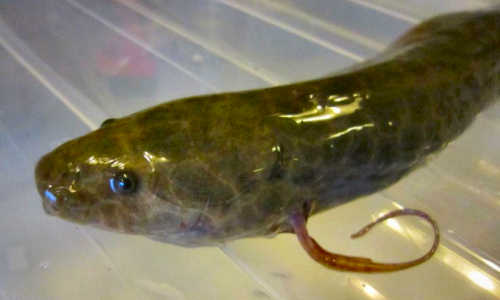Lungfish and salamanders can hear, despite not having an outer ear or tympanic middle ear. These early terrestrial vertebrates were probably also able to hear 300 million years ago, as shown in a new study by Danish researchers.
The lungfish ear is a good model for the ears of the first terrestrial vertebrates. A new study shows that they are capable of detecting airborne sound despite not having a tympanic middle ear. Photo Credit: Christian Bech Christensen
Lungfish and salamander ears are good models for different stages of ear development in these early terrestrial vertebrates. Two new studies published in the renowned journals Proceedings of the Royal Society B and The Journal of Experimental Biology show that lungfish and salamanders can hear, despite not having an outer ear or tympanic middle ear. The study therefore indicates that the early terrestrial vertebrates were also able to hear prior to developing the tympanic middle ear. The research findings thus provide more knowledge about the development of hearing 250–350 million years ago.
The physical properties of air and tissue are very different, which means in theory that up to 99.9% of sound energy is reflected when sound waves reach animals through the air. In humans and many other terrestrial vertebrates, the ear can be divided into three sections: the outer ear, the middle ear and the inner ear. The outer ear catches sound waves and directs them into the auditory canal. In the middle ear, pressure oscillations in the air are transferred via the tympanic membrane (eardrum) and one or three small bones (ossicles) to fluid movements in the inner ear, where the conversion of sound waves to nerve signals takes place. The tympanic middle ear improves the transfer of sound energy from the surroundings to the sensory cells in the inner ear by up to 1,000 times, and is therefore very important for hearing in terrestrial vertebrates. This is reflected in the fact that different configurations are found in the vast majority of present-day terrestrial mammals, birds, reptiles and amphibians. However, available palaeontological data indicate that the tympanic middle ear most likely evolved in the Triassic period, approximately 100 million years after the transition of the vertebrates from an aquatic to a terrestrial habitat during the Early Carboniferous. The vertebrates could therefore have been deaf for the first 100 million years on land.
It is obviously not possible to study the hearing of the early terrestrial vertebrates, which became extinct long ago. However, by studying the hearing of present-day vertebrates with a comparable ear structure, it is possible to learn about the hearing of the early terrestrial vertebrates and the development of aerial hearing. A team of Danish researchers from Aarhus University, Aarhus University Hospital and the University of Southern Denmark therefore studied the hearing of lungfish and salamanders, which have an ear structure that is comparable to that of different kinds of early terrestrial vertebrates.
They studied the hearing of lungfish and salamanders by measuring auditory nerve signals and neural signals in the brainstem as a function of sound stimulation at different frequencies and at different levels. Surprisingly, the measurements showed that not only the terrestrial adult salamanders, but also the fully aquatic juvenile salamanders – and even the lungfish, which are completely maladapted to aerial hearing – were able to detect airborne sound despite not having a tympanic middle ear. By studying the animals’ sense of vibration, the researchers were able to demonstrate that both lungfish and salamanders detect sound by sensing the vibrations induced by sound waves.
The results show that even vertebrates without outer and middle ears are capable of detecting airborne sound. This means that adaptation to aerial hearing following the transition from aquatic to terrestrial lifestyles during the Early Carboniferous was presumably a gradual process, and that the early terrestrial vertebrates without tympanic middle ears were not deaf to airborne sound during the first 100 million years on land. In addition to making us wiser about hearing in general, the results can provide inspiration in the future to developing clinical treatments for hearing loss.
Story Source:
The above story is based on materials provided by Aarhus University.





